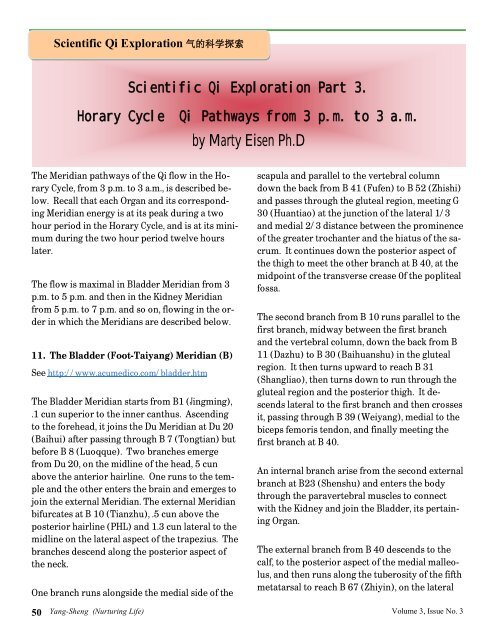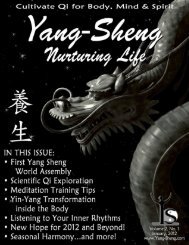Scientific Qi Exploration 气 的 科 学 探 索Scientific Qi Exploration Part 3.Horary Cycle Qi Pathways from 3 p.m. <strong>to</strong> 3 a.m.by Marty Eisen Ph.DThe Meridian pathways of the Qi flow in the HoraryCycle, from 3 p.m. <strong>to</strong> 3 a.m., is described below.Recall that each Organ and its correspondingMeridian energy is at its peak during a twohour period in the Horary Cycle, and is at its minimumduring the two hour period twelve hourslater.The flow is maximal in Bladder Meridian from 3p.m. <strong>to</strong> 5 p.m. and then in the Kidney Meridianfrom 5 p.m. <strong>to</strong> 7 p.m. and so on, flowing in the orderin which the Meridians are described below.11. The Bladder (Foot-Taiyang) Meridian (B)See http://www.acumedico.com/bladder.htmThe Bladder Meridian starts from B1 (Jingming),.1 cun superior <strong>to</strong> the inner canthus. Ascending<strong>to</strong> the forehead, it joins the Du Meridian at Du 20(Baihui) after p<strong>as</strong>sing through B 7 (Tongtian) butbefore B 8 (Luoqque). Two branches emergefrom Du 20, on the midline of the head, 5 cunabove the anterior hairline. One runs <strong>to</strong> the templeand the other enters the brain and emerges <strong>to</strong>join the external Meridian. The external Meridianbifurcates at B 10 (Tianzhu), .5 cun above theposterior hairline (PHL) and 1.3 cun lateral <strong>to</strong> themidline on the lateral <strong>as</strong>pect of the trapezius. Thebranches descend along the posterior <strong>as</strong>pect ofthe neck.One branch runs alongside the medial side of thescapula and parallel <strong>to</strong> the vertebral columndown the back from B 41 (Fufen) <strong>to</strong> B 52 (Zhishi)and p<strong>as</strong>ses through the gluteal region, meeting G30 (Huantiao) at the junction of the lateral 1/3and medial 2/3 distance between the prominenceof the greater trochanter and the hiatus of the sacrum.It continues down the posterior <strong>as</strong>pect ofthe thigh <strong>to</strong> meet the other branch at B 40, at themidpoint of the transverse cre<strong>as</strong>e 0f the poplitealfossa.The second branch from B 10 runs parallel <strong>to</strong> thefirst branch, midway between the first branchand the vertebral column, down the back from B11 (Dazhu) <strong>to</strong> B 30 (Baihuanshu) in the glutealregion. It then turns upward <strong>to</strong> reach B 31(Shangliao), then turns down <strong>to</strong> run through thegluteal region and the posterior thigh. It descendslateral <strong>to</strong> the first branch and then crossesit, p<strong>as</strong>sing through B 39 (Weiyang), medial <strong>to</strong> thebiceps femoris tendon, and finally meeting thefirst branch at B 40.An internal branch arise from the second externalbranch at B23 (Shenshu) and enters the bodythrough the paravertebral muscles <strong>to</strong> connectwith the Kidney and join the Bladder, its pertainingOrgan.The external branch from B 40 descends <strong>to</strong> thecalf, <strong>to</strong> the posterior <strong>as</strong>pect of the medial malleolus,and then runs along the tuberosity of the fifthmetatarsal <strong>to</strong> reach B 67 (Zhiyin), on the lateral50 <strong>Yang</strong>-<strong>Sheng</strong> (Nurturing Life) Volume 3, Issue No. 3
the Kidney, its pertaining Organ, and then descends<strong>to</strong> the Bladder and returns <strong>to</strong> K 11(Hengu), 5 cun below the navel on the superiorborder of symphysis pubis, .5 cun lateral <strong>to</strong> themidline of the body.From K 11, the external Meridian <strong>as</strong>cends the abdomenand chest <strong>to</strong> terminate in K 27 (Shufu), inthe depression on the lower border of the clavicle,2 cun lateral <strong>to</strong> the midline.A branch emerges from the Kidney <strong>as</strong>cends,p<strong>as</strong>ses through the Liver and diaphragm, entersthe Lung, runs up along the throat and terminatesat the root of the <strong>to</strong>ngue.side of the small <strong>to</strong>e, about .1 cun posterior <strong>to</strong> thenail’s corner. B 67 is the point linking the BladderMeridian with the Kidney Meridian.2. The Kidney (Foot-Shaoyin) Meridian (K)See http://www.acumedico.com/kidney.htmThe Kidney Meridian starts at B 67 and runsobliquely from the inferior <strong>as</strong>pect of the little <strong>to</strong>e<strong>to</strong>wards the sole <strong>to</strong> K 1(Yongquan), located betweenthe second and third metatarsal bones, approximatelyone third of the distance betweenthe b<strong>as</strong>e of the second <strong>to</strong>e and the heel, in a depressionformed when the foot is plantar flexed.Emerging from the depression on the lower borderof the tuberosity of the navicular bone at K 2(Rangu), it runs behind the medial malleolus atK3 (Taixi) <strong>to</strong> the heel at K 4 (Dazhong). Then, it<strong>as</strong>cends along the medial side of the leg <strong>to</strong>K 9 (Zhubin) and <strong>to</strong> the medial side of the poplitealfossa <strong>to</strong> K 10 (Yingu). Then, it runs furtherupward along the postero-medial thigh <strong>to</strong>wardsDu 1 Changqiang), midway between the tip of thecoccyx and anus. There it runs upward <strong>to</strong> enterA branch emerges from the Lung, joins the Heartand flows in<strong>to</strong> the chest <strong>to</strong> link with the PericardiumMeridian.13. The Pericardium (Hand-Jueyin) Meridian(P)See http://www.acumedico.com/pericardium.htmThe Pericardium Meridian originates in the chestand enters its pertaining Pericardium Organ.Then, it descends through the diaphragm <strong>to</strong> theabdomen connecting with the Upper, Middle andLower Burners or the Sanjiao.A branch arising from the chest runs inside thechest and emerges at P 1 (Tianchi), in the fourthintercostal space, 1 cun lateral <strong>to</strong> the nipple. It<strong>as</strong>cends <strong>to</strong> the P 2 (Tianquan), 2 cun below theend of the anterior axillary fold, between the twoheads of the biceps brachii muscles. From P 2, itdescends the medial <strong>as</strong>pect of the upper arm, betweenthe Lung and Heart Meridians, <strong>to</strong> P3(Quze), on the transverse cubital cre<strong>as</strong>e, at theulnar side of the tendon of the biceps brachiimuscle. Continuing down the forearm, it p<strong>as</strong>sesbetween the tendons of the palmaris longus andJune-July 2013 <strong>Yang</strong>-<strong>Sheng</strong> (Nurturing Life) 51
- Page 1 and 2: Cover should go hereDraft for Comme
- Page 3 and 4: Volume 3, No. 3 www.Yang-Sheng.com
- Page 8 and 9: is to smile from the heart, mind, b
- Page 10 and 11: You’ll start with a pill for bloo
- Page 12 and 13: May;44(5):1360-8. By Threapleton DE
- Page 14 and 15: cancer in the Health Professionals
- Page 16 and 17: decrease in BMI of 8% was the thres
- Page 18 and 19: Ancient Wisdom, Modern Kitchen 古
- Page 20 and 21: From The Doctor 医 生 之 窗Rais
- Page 22 and 23: way, make your food come alive in t
- Page 24 and 25: Meditation in Motion 动 中 冥
- Page 26 and 27: try shows that “Chronic “lifest
- Page 28 and 29: far from ideal: “I estimate I spe
- Page 30 and 31: neered the concept of self-care by
- Page 32 and 33: Book Review 书 评Book Review: Hea
- Page 34 and 35: more awakened and real to you if yo
- Page 36 and 37: Daoist Internal Alchemy 道 家 内
- Page 38 and 39: Qi Cultivation and Dao 炼 气 与
- Page 40 and 41: etween physician and patient, betwe
- Page 42 and 43: neutralize, and transform unhealthy
- Page 44 and 45: make a difference in outcomes. Chap
- Page 46 and 47: dary Yang Cheng Fu, mentioned the f
- Page 48 and 49: the senior students, a disciple of
- Page 52 and 53: flexor carpi radialis muscles, endi
- Page 54 and 55: dial end of the popliteal crease (f
- Page 56 and 57: yourself.This year’s Building Bri
- Page 58 and 59: ¼ cup goji berries2-3 fresh mint l
- Page 60 and 61: from the plant's air channels. Lotu
- Page 62 and 63: Yang-Sheng Needs Your Financial Sup













